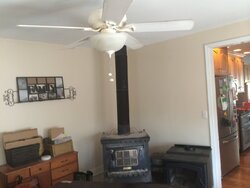Hey fellers,
Got an off the wall question for you all. I recently installed a Century Heating CW2900 insert in my fireplace. I like it so far, for the most part. The blower leaves quite a bit to be desired. It feels like it just doesn't quite shove the air out like I want and or need it to. Its rated at 130CFM. Single squirrel cage type, underneath the door. Dad's buck stove insert pushes hot air 8' out away from the fireplace, mine blows it a foot or two out. Is there a way to retrofit another manufacturers blower on another's insert? Or is there a way to hop my blower up so to speak? It stays nice and toasty in the living room, with more oomph I think I can heat the rest of the house. Thanks for the replys!
Got an off the wall question for you all. I recently installed a Century Heating CW2900 insert in my fireplace. I like it so far, for the most part. The blower leaves quite a bit to be desired. It feels like it just doesn't quite shove the air out like I want and or need it to. Its rated at 130CFM. Single squirrel cage type, underneath the door. Dad's buck stove insert pushes hot air 8' out away from the fireplace, mine blows it a foot or two out. Is there a way to retrofit another manufacturers blower on another's insert? Or is there a way to hop my blower up so to speak? It stays nice and toasty in the living room, with more oomph I think I can heat the rest of the house. Thanks for the replys!



